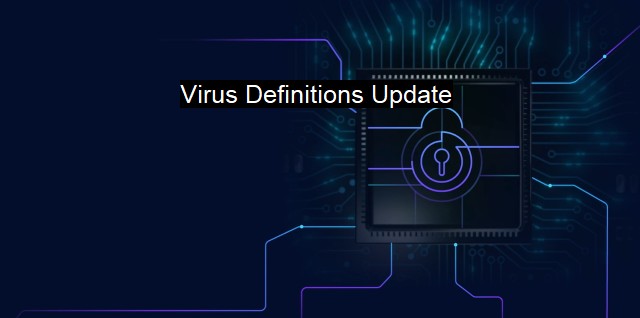What is Virus Definitions Update?
The Importance of Virus Definition Updates in Cybersecurity: Understanding Malware and Software Protection
In the complex world of cybersecurity, the term "Virus Definitions Update" summons immediate recognition and comprehension. This kernel of our digital defense serves as an essential component in the reliable protection of our computer systems, databases, and personal information. To comprehend why it's essential, it's vital to understand what it is, how it works, and why it play it is a keystone in cyber-defense strategy.Virus Definitions Update is crucial software updates for your antivirus program. Each antivirus software includes a vast library storing "definitions" of these potentially dangerous programs—viruses, malware, adware, spyware, and so on. Each definition is essentially a pattern—a digital fingerprint identifiable as a harmful entity. This inclusive library forms what we know as the Virus Definitions Database.
The role of the Virus Definitions Database is continuous monitoring of your computer's data, comparing every file's digital DNA to the stored definitions in the database. If the antivirus program spots a match, it flags it as potential malware, handles it per its programming, either by quarantining, deleting or disinfecting it, and serves to preserve the integrity of your digital landscape.
Given the upwardly evolving nature of harmful software like computer viruses, the Virus Definitions Database needs to be constantly updated, which is achieved by the Virus Definitions Update. While databases existing at a particular time may successfully rocognize and intercept known threats, new threats emerge and evolve regularly in our fast-paced world. As such, the database, and subsequently, its complimentary antivirus solutions, run the risk of becoming obsolete without a system for continual updates.
Not updating a Virus Definitions Database is like going into an examination with Outdated study materials. The emergent threats blocker's performance will, in every likelihood, flounder. These updates ensure that antivirus solutions are knowledgeable, prepared, and powerful enough to deliver on their primary task — protecting your systems and data from modern emerging threats.
Generically, virus definition updates happen regularly — daily decals or even hourly in some cases. The speed and frequency of these updates directly correlate to the efficiency and resiliency of an antivirus solution. Reducing the time gap between virus discovery and definition update installation means less potential vulnerability and greater cybersecurity.
Apart from the antivirus software provider’s proactive actions in offering these updates, user accountability also plays a significant role in cybersecurity hygiene. Not routinely executing the provided Virus Definitions Update is tantamount to grossly undermining the antivirus. It's estimated that a significant percentage of successful cyber-attacks could be thwarted by effective updating - crippling the grandeur of defensive systems disregarding regular updates.
An organization or individual should pay meticulous attention to the virus definitions update alongside software updates and patch management as they are equally significant. Besides, they should consider partnering with a reliable antivirus software provider to ensure timely and continuous updates are offered.
Neglecting these updates brings leaner dosages of its benefits, culminating in untoward results such as theft or corruption of data, the violation of a privacy policy, or allowing access of unauthorized individuals to one's portfolios. Considering how frequently developers discover new viruses and malware, it's quintessential to install virus definition updates throughout the cycle.
The role of "Virus Definitions Updates" in cybersecurity is monumental. As malware evolves and more threats surface, updates to virus definitions become instrumental in maintaining the efficacy and relevancy of antivirus software. Regularly updating your Virus Definitions Database improves the chances of warding off cyber threats, thus securing your computer and data massively. In executing these updates, we become partakers in cybersecurity's evolving narrative, forestalling the dark consequences of our growing digital realm.

Virus Definitions Update FAQs
What are virus definitions?
Virus definitions are a set of data used by antivirus software to identify and classify malware. These definitions contain specific characteristics and signatures that help antivirus software recognize and remove known threats from infected systems.Why is it important to update virus definitions regularly?
Updating virus definitions regularly is essential to ensure that an antivirus program can detect and remove the latest malware threats. Cybercriminals constantly develop new viruses and malware to evade detection, and antivirus software must keep pace with these developments to provide effective protection.How often should I update virus definitions?
It is recommended to update virus definitions at least once a day or as often as your antivirus software allows. Frequent updates ensure that your system is protected against the latest cyber threats.What happens if I don't update virus definitions?
If you don't update virus definitions, your antivirus software will not be able to recognize and remove new types of malware. This puts your system at risk of becoming infected, which can result in data loss, system damage, and other consequences. Updating virus definitions regularly is a crucial step in protecting your computer from cyber attacks.| | A | | | B | | | C | | | D | | | E | | | F | | | G | | | H | | | I | | | J | | | K | | | L | | | M | |
| | N | | | O | | | P | | | Q | | | R | | | S | | | T | | | U | | | V | | | W | | | X | | | Y | | | Z | |
| | 1 | | | 2 | | | 3 | | | 4 | | | 7 | | | 8 | | |||||||